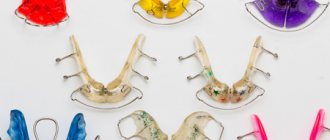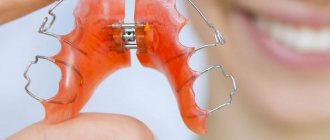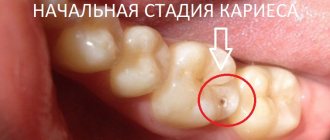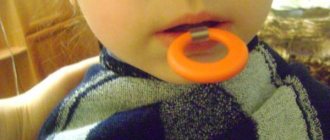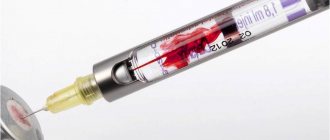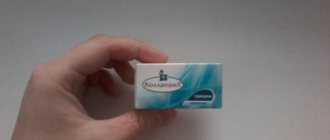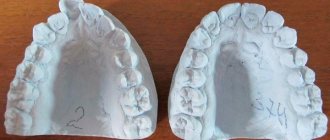509
Mechanical orthodontic devices use screws, labial and oral archwires, springs, and elastomers to generate force.
The screws create an intermittent force that decreases relatively quickly from maximum to low, after which the screw is activated again.
Arcs, springs and elastomers are used in devices with constant force, which do not require activation at all or are activated less often than screw ones.
Item overview
The Coffin spring is a wire figure in the form of a ring, the ends of which, not reaching each other, are bent to the sides. The force it creates is directed along a line passing through the open ends.
The latter are attached to the metal or polymer parts of the device by soldering or during the polymerization of the acrylic base (filled with a hardening polymer).
The element is used mainly as a power element of devices, to expand and lengthen the upper dental arch . Placed with its central, rounded part in the palatal recess, and resting its ends on the segments of the base, Coffin’s design organically fits into the apparatus and the upper jaw.
To expand the mandible, the Koller zigzag design is usually used.
The advantages of Coffin's design are:
- ease of manufacture;
- the ability, depending on the location, to expand and lengthen the top row in the segment in which it is required.
Disadvantage – inability to use for anomalies of the lower jaw.
For what purpose is the Marco Ross apparatus installed in orthodontics, and how does the device work?
Come here to take a closer look at Nord's apparatus.
At this address https://www.vash-dentist.ru/ortodontiya/plastinyi/profilakticheskimi-apparatami.html we will talk about modern preventive orthodontic devices for children.
Derichsweiler apparatus
The design is a mechanism that consists of main rings and corrective arcs. The support rings are fixed on the back teeth, where there is an attached lock on which the arches are attached.
They converge near the palatal arch, where the activator is located. This is a screw that transmits systematic pressure to the palate. The palatal suture expands, resulting in the jaw becoming wider. The gap that is formed when the palate opens is filled after some time with other soft tissue.
The device is prescribed for narrowing of the jaw arch during the first mixed bite. If the disease has formed in the permanent dentition, then the unit will have the least result, because it cannot cope with the hardened palatal suture. The device has its advantages:
- The dental expander has a plastic effect during correction, and there is no discomfort while wearing.
- The device cannot be removed independently, so correction is carried out in a minimum period of time.
- The device does not damage delicate gum tissue.
Like any device, the design has disadvantages. On the first day of wearing, maximum salivation and impaired pronunciation of words are noticed. Sometimes the surface of the tongue is injured. It is impossible to adjust the device yourself; to do this you need to visit a dentist.
Varieties
There are the following types of Coffin springs. Depending on the number of circuits:
- single (wire goes in one row);
- double (the wire is laid in two rows, i.e., in fact, there are 2 almost identical structures, one of which is inserted into the other, as a result of which the force they create increases).
The elasticity and movement of the element is affected by the size of its ring. Small allows you to place two products in the base, facing each other with closed parts. In addition to compactness, they are characterized by low stroke and high rigidity.
Springs with a larger ring have less rigidity but greater travel. They need activation more rarely than with small ones.
Coffin spring connecting palatal plastic pelota. 3 page
Previous54NextThe use of a cap with a chin sling and an extraoral rubber rod allows you to eliminate the habitual protrusion of the lower jaw. It is advisable to use this device simultaneously with the Bruckle apparatus during the day, then the Bruckle apparatus around the clock, and the device with extraoral traction - 8-10 hours a day. During the week, the child should eat softened food and eat it without removing the device. After the vestibular deviation of the upper incisors and their overlap with the lower ones, the inclined plane is removed and it is recommended to use this device for about a month to retain the achieved results. If, after moving the upper incisors, gaps remain between the lateral teeth , which happens when treating mesial occlusion with deep incisal overlap, then a retention plate for the upper jaw should be made with Adams clasps or round ones open posteriorly 6 IV | IV 6
The palatal surface of the displaced teeth should be covered as much as possible with plastic to prevent recurrence of the anomaly. In the anterior section of the plate, a bite pad is made for the lower incisors, taking into account the depth of the achieved incisal overlap
The patient should use the device until contacts appear between the lateral teeth due to their eruption, which helps eliminate deep bite.
With the gnathic form of mesial occlusion, caused by an increase in the size of the lower jaw, the objectives of orthodontic treatment are to delay its growth and create conditions for the active growth of the upper jaw.
A fixed orthodontic appliance for the treatment of mesial occlusion, proposed in 1988 by F. Ya. Khoroshilkina, Yu. M. Malygin, E. A. Volsky, L. V. Serikova, Yu. A. Gioeva, consists of support rings for the last permanent molars of the lower jaw, a dental vestibular arch soldered to them, transmitting pressure to the lateral teeth of the lower jaw in the distal direction, and a springy vestibulo-oral device soldered to the supporting arch, deflecting the anterior teeth of the upper jaw in the vestibular direction when the dentitions close.
When manufacturing such an apparatus, the constructive bite is first determined, increasing it until the reverse incisal overlap is eliminated and the lower jaw moves backward if it was shifted forward. Rings ^ of the finished apparatus are fixed simultaneously on the supporting teeth using phosphate or visphat cement. Needs tight ,
the fit of the oral device to the palatal surface of the moving teeth, below their dental cusps. Compression of the bends of the vestibulo-oral device simultaneously increases the pressure on the anterior teeth of the upper jaw in the vestibular direction and on all the teeth of the lower jaw in the distal direction (Fig. 16.28). uh,
In the process of vestibular deviation of the anterior teeth, jaws are adjusted in order to adjust the height of the bite and the depth of the incisal overlap, compressing or releasing horizontally located V-shaped bends, strengthening or weakening! pressure on the upper incisors in the vertical direction. The treatment effect is ensured due to the following design features: ;
1) the device is single-jaw, but intermaxillary;
2) with an increase in the support of the apparatus, the desired preferential movement of the upper anterior teeth is achieved! jaws;
3) a non-removable device ensures round-the-clock use, and therefore speeds up treatment;
4) the movement of the anterior teeth of the upper jaw occurs without hypercorrection;
5) the vestibular deviation of the upper incisors is better managed and controlled by compressing the curves of the vestibulooral arch;
6) changes in dentoalveolar height in the area of the upper anterior teeth can be achieved by compressing horizontally directed V-shaped bends.
A cap with a chin sling and extra-oral traction is a device for retarding the growth of the lower jaw. Extraoral traction should be directed from the chin towards the articular processes, i.e. backward and upward, which retards the growth of the lower jaw and contributes to a change in its shape, in particular reducing the angles. Extraoral traction is effective when used during periods of active growth of the lower jaw in length, which are partially coincide with the periods of eruption:
1) first permanent molars and incisors;
2) canines and second permanent molars;
3) third permanent molars
However, as noted above, the quantitative growth of bone tissue in girls and boys does not coincide by age, so it is advisable to prescribe extraoral traction for girls at 5-7 and 10-13 years old, and for boys at 5-7 and 12-15 years old. In addition to these single periods, it is advisable to focus on periods of ac-
Rice. 16.29. Double-jaw appliances for the treatment of mesial occlusion.
1 — double Schwartz plate; 2 - Andresen-Heupl activator; 3 — Brady and Yungto activator; 4 — Balters bionator HI type; 5 — Bimler bite former of group “c”.
selection of growth of the jaws and the whole organism or its slowdown associated with individual developmental characteristics.
For the treatment of pronounced dentoalveolar forms of mesial occlusion and especially gnathic ones, functional devices are used. Modifications of these devices have different names, emphasizing the features of their operation; their difference from each other is not always significant. More often they are combinations of elements of previously known devices. The positive side of such devices is the simultaneous effect on both jaws.
To pull the upper jaw forward and downward, special face masks, fixed appliances for the upper jaw, and extraoral traction are used.
The Schwartz double plate consists of two parts that act on both jaws when the dentitions are closed:
1) plates for the upper jaw with an expansion screw and Schwartz arrow-shaped clasps (for protrusion
a lingual arch or spring is used in the upper teeth);
2) plates for the lower jaw (for the purpose of retrusion of the lower incisors, a vestibular arch is used, and Schwartz arrow-shaped clasps are used to fix the apparatus) (Fig. 16.29).
The mandibular plate should not be adjacent to the lingual surface of the lower anterior teeth and the alveolar process. A rigid metal pin is fixed in its anterior section, directed from bottom to top and from front to back. When the jaws are closed, the pin slides along the upper plate and transmits pressure to the upper jaw, which promotes its growth and mesial movement of the teeth, and the reactive force retards the growth of the lower jaw.
The clinical and laboratory stages of plate production are normal. After determining the constructive bite and establishing the lower jaw in the distal position, the jaw models are plastered in an occluder. The metal pin is made from a special blank used for a clasp arch when replacing partial defects in the dentition, or it is cast from metal (steel, vitalium, etc.). Notches are made on the part of the pin that is located at the base of the lower plate to ensure its best fixation in the plastic. You can use ready-made standard metal pins for double Schwarz plates. In the base to which the pin is attached, a small depression is made according to its shape, maintaining an even layer of plastic to prevent damage to the device.
Basharova's apparatus of functional-mechanical action is a removable plate for the lower jaw, not adjacent to the mucous membrane of the alveolar process in the area of the incisors, canines and the crowns of these teeth. In its anterior section there are reversible metal bands (dental retractors) made of stainless steel sheet grade 1Х18Н9Т with a thickness of 0.4 mm, a width of 3-5 mm, a length of 60-70 mm, which are fixed in the base of the device. Retractors forming an inclined plane separate the lateral teeth. They should not touch the cutting edges and lingual surfaces of the lower incisors and canines, they should be 3 mm away from them. Their ends are led to the labial surface of the lower incisors and canines. retraction vestibular vestibule is applied to the rim ends.
U-shaped bends. The metal plates are adjusted taking into account the movement of each upper and lower ^a in the desired direction. The force of muscle contractions is transmitted through the “flexible inclined plane” to the upper teeth and ensures their vestibular movement.
tion, as well as on the lower front teeth in the oral direction.
To consolidate the results of treatment of mesial occlusion and additional correction of the position of individual teeth, O. M. Basharova (1971) proposed a bite former, consisting of a palatal plate and a guide plane made of a continuous series of wire bends. Such a guide plane is bent from orthodontic wire with a cross-section of 0.6 mm for treatment in the period of temporary and 0.8 mm - permanent dentition. Using pliers, make six wire bends; their height is from 5 to 10 mm, width from 3 to 4 mm. If maxillary expansion is indicated, is added .
The Andresen a-H o i p l activator for the treatment of mesial occlusion consists of two base plates for the upper and lower jaws, connected to each other by plastic in the interocclusal space. The device has the following differences from the activator, designed to eliminate distal bite. When determining a constructive bite, the lower jaw is moved back as much as possible, the front teeth are set, if possible, in marginal closure or their cutting edges are at the same horizontal level. The bite is separated in the anterior part of the dentition due to occlusal overlays on the lower lateral teeth. Such onlays should be in contact with the cusp tips of the upper lateral teeth, but not retard their medial movement. The vestibular arch is located in the area of the lower front teeth. If there are three between them, it is activated during the treatment process, and the plastic adjacent to the lingual surface of these teeth is cut down. To enhance the protrusion of the upper incisors, a screw is added to the activator; cutting is done sectorally. Protracting springs or arcs are also used.
The activator is effective in the treatment of mesial occlusion with a small reverse incisal overlap (up to 1.5 mm) or with an open bite combined with the bad habit of sucking the tongue or placing it between the dentition in the area of the defect. In the latter case, vertically directed extraoral traction (a cap with a chin sling and rubber traction) is also used. Long-term use of such an activator can lead to an increase in incisal overlap, therefore, as the upper anterior teeth move, the occlusal pads are filed down.
The activator is also used to eliminate crossbite. If there is a discrepancy in the position of the lateral teeth (narrowing of the upper dentition and expansion of the lower), devices are added to the activator that move the lateral teeth.
Fig. 16 30. Wunderer activator with screws of various designs (a, b) and horizontal cutting of the base in the area of the molars (c).
In this case, the occlusal pads are kept on the side of the correctly formed bite and filed down on the opposite side. Normalization of the bite occurs due to correction of the position of the lower jaw, the location of the teeth, the development of the articular process and the branch of the lower jaw on the side of the deformity.
The Wunderer activator consists of two plastic plates for the upper and lower jaws, occlusal pads for the lateral teeth, sawn in a horizontal direction, a vestibular arch in the area of the lower front teeth, a screw located in the anterior section of the dentition and connecting the upper part of the apparatus to the lower. When the screw is activated, the pressure of the apparatus on the teeth of the upper jaw is transmitted in the mesial direction, and in the lower jaw - in the distal direction (Fig. 16.30). The best results with this device can be achieved in the treatment of mesial occlusion combined with an open or slight reverse incisal overjet, since occlusal overlays on the lateral teeth facilitate their implementation. The screw takes up a lot of space in the mouth, which significantly complicates the movement of the tongue and changes its position, making the device difficult to use for a long time, especially during the day.
The clinical and technical steps for the manufacture of the Wunderer activator are similar to those for the manufacture of the Andresen-Heupl activator.
It is important to cut both parts of the device in parallel. If an error occurs and the angle of the cut is made incorrectly, then the gap between the two parts of the apparatus is increased in those areas where they abut one another.
| Rice. 16.31. Types of open activators for the treatment of crossbite. |
| Rice. 16.32. Frenkel clasp activator (schematic representation of the parts of the apparatus). |
The Hoffman activator serves the same purpose as the Wunderer activator. To influence the upper dentition in the mesial direction, and the lower one in the distal direction, two screws are used, placing them parallel in the area of the lateral teeth, which frees up space for the tongue in the anterior area and promotes its correct position.
Open Klammt activator - oral appliance. Its base is located in the area of the upper and lower jaws from the canine to the first or second molar, as a result of which there is sufficient space for the tongue in the anterior area. For the vestibular deviation of the upper incisors, a lingual arch and springs are used, for the oral inclination of the lower incisors, a vestibular dental arch is used, and a Coffin screw or spring is used to expand the dental arches. In addition to these elements, according to indications, occlusal pads are used in the area of the lateral teeth to separate the anterior teeth and auxiliary devices - shields, pelota, stops for
keeping the tongue away from the teeth. An open activator is made after determining the constructive bite with the maximum distal shift of the mandible. It is recommended to use the device throughout the day, as a result of which the function of the masticatory and facial muscles undergoes a quicker restructuring (Fig. 16.31).
The Frenkel clasp activator consists of base plates for the upper and lower jaws, occlusal plastic overlays for the lateral teeth, a vestibular arch in the area of the lower anterior teeth and a screw located in the distal part of the hard palate and behind it a rigid (usually cast) arch. The plates are separated by horizontal cuts. It is important that they are parallel on both sides of the activator, which ensures unhindered sliding of the plastic when the screw is unscrewed (Fig. 16.32). It is quite difficult to saw the finished apparatus correctly, so first they make a plastic plate for the upper jaw with protracting springs, a screw and a clasp. In the area of the screw, the plastic is cut sectorally so that the pressure of the screw, when unscrewing, is transmitted to the teeth of the upper jaw in the anterior direction, and to the teeth of the lower jaw through the clasp in the posterior direction. Then spacers are applied at the place where the plates are separated, after which a plate is made for the lower jaw. During the manufacturing process of the activator, when determining the constructive bite, the lower jaw is shifted as much as possible in the distal direction.
The advantages of an open activator over others are that it creates conditions for the correct positioning of the tip of the tongue. The screw is placed in the deep part of the palate, which makes it easier to pronounce sounds. The device can be used not only at night, but also during the day.
The functional Buni apparatus is a removable expanding plate for the upper jaw with a Coffin spring and clasps. To move the tongue away from the teeth, a plastic shield is created in the anterior section of the plate. As the upper dentition expands, a gap is formed between the two halves of the shield into which the tongue penetrates. To close this gap, grooves are made in both halves of the shield. In one of them a plate made of elastic plastic is fixed; the free end is inserted into the groove on the opposite side. This plate does not prevent the expansion of the device. It slides along one of the grooves and closes the resulting gap. The vestibular arch is fixed in the plate, exerting pressure on the lower front teeth. The effect of the vestibular arch is enhanced with the help of loops curved in the area of the upper canines. The upper lip is pulled forward by the pilots,
which are attached to the plate with pieces of wire. The lower border of the pelotes is at the level of the upper third of the crowns of the incisors, the upper - at the level of the middle of their roots. The device prevents sucking of the upper lip and tongue, helps normalize swallowing; The device's pilots move the upper lip away from the teeth, making it easier to close the lips.
Such an apparatus for the upper jaw complicates the function of the tongue and especially its tip. The pelota are located low, and therefore do not sufficiently activate the growth of the apical base of the upper jaw. Without sufficient bilateral support, they can move posteriorly under the pressure of the lip until they come into contact with the mucous membrane of the alveolar process, which can retard the growth of the upper jaw. There are no parts that separate the bite, so the use of such an apparatus should be limited to cases of mesial occlusion combined with an open or small incisal overlap, when separation is achieved due to the thickness of the clasps. The listed disadvantages limit the use of this device.
The Balters bionator, through shields, protects the dentition from being pulled between them by the mucous membrane of the lips and cheeks, promotes lip closure, and normalizes the position of the tongue, teeth and lower jaw. Since malocclusion is usually combined with hypokinesis (lack of movement), the success of orthodontic treatment is achieved through intense movements, normalization of posture, respiratory function, blood and lymph circulation. W. Balters considers therapeutic exercises to be the main means for eliminating malocclusions.
Of the three types of bionators, the third is intended for the treatment of mesial occlusion. The device consists of lingual side plastic shields that prevent the tongue from getting between the dentition. These shields extend from the distal surface of the first permanent molars and cover the lingual surface of the posterior teeth; in the anterior section of the lower jaw they are connected, which increases the support of the apparatus. In addition, occlusal pads on the lower temporary molars are used as a support.
The vestibular arch is placed in the area of the lower teeth, which, in combination with occlusal overlays on the lower lateral teeth, retards the growth of the lower jaw. To eliminate the pressure of the cheeks and their entry into the interocclusal space, the arch is bent in the lateral areas in the form of rectangular processes that are not adjacent to the teeth, but are spaced 2 mm from them. The ends of the arch are placed between the canines and the first temporary molars and fixed in the lingual shields of the bion-
Torah. Additional parts are attached to the bionator - plastic shields for retracting the cheeks (Fig. 16.33). Removing the upper lip from the front teeth using a maxillary shield stimulates the growth of the upper jaw. If you have a short upper lip, mouth breathing, or an open bite, an additional removable shield is made in the form of a vestibular plate, which is attached to the device during sleep. The bionator should be used first during the day, except when at school, and then during the day and at night. The optimal time for treating dental anomalies using the Balters method is the period of mixed dentition. However, positive treatment results can be achieved in the prepubertal period. Duration of treatment is from 1 to 2.5 years.
The bionator is not indicated in the absence of many teeth, in particular primary molars and first permanent molars, since the support of the device deteriorates. In such cases, better results can be achieved with open activators that transfer pressure to the palate.
Device for eliminating mesial occlusion. The device proposed by F. Ya. Khoroshilkina and I. V. Tokarevich (1985) does not have significant technical differences with the device for the treatment of distal occlusion (see Fig. 16.1). The dental part of the vestibular arch is adjacent to the lower incisors, and arm-shaped springs cover the distal surface of the first molars of the upper jaw; occlusal base overlays are made for the lower lateral teeth. Correction of the bite is carried out as follows. The jaws are set in a constructive bite, due to which the lower jaw tends to return to its original position and exerts pressure on the base of the apparatus, mounted on the front teeth of the upper jaw, as well as on the arm-shaped springs, mounted on the last molars of the upper jaw. The base of the device transmits the impact on the teeth of the upper jaw in the vestibular direction. In addition, the dental arch enhances the action of the device due to the bilateral traction applied between the hooks of the vestibular arch and the hooks of the arm-shaped springs. As the mandibular anterior teeth move, the sliding dental arch moves distally, exerting a constant and continuous force on the lower teeth. The counterforce moves the lateral teeth of the upper jaw forward.
The device by Zubkova and Khoroshilkina for the treatment of mixed medial bite is an open activator made of plastic, consisting of a base for the upper and lower jaws, connected by occlusal pads in the area of the chewing surface.
Rice. 16.33. Balters bionator for the treatment of mesioocclusion.
the strength of the lateral teeth of both jaws. The anterior portion of the palate and the dentoalveolar arch in the area of the incisors and canines of the upper jaw are not covered with plastic. There are 2 upper labial pelots and 3 wire elements connecting the upper labial pelots, as well as the latter to the base of the device. These pelota remove the upper lip from the alveolar process and relieve its pressure on the anterior portion of the apical base of the upper jaw on the vestibular side, which promotes growth in this area and body movement of the anterior teeth in the vestibular direction. Their movement is accelerated by the pressure of the plastic pelots, transmitted to the palatal surface of each maxillary incisor. Pelota are fixed on a wire arch, curved to the shape of the palatal surface of the front teeth. Its ends are inserted into the vestibule of the oral cavity from the distal side of the crowns of the first premolars or first temporary molars, after which the wire is bent in semicircles upward and forward, placing them parallel to the vestibular surface of the crowns of the first premolars or temporary molars. Then the ends of the arch are inserted into the base of the device behind the fangs and fixed in plastic. By compressing the bends of the arch, the vestibular movement of the anterior teeth is enhanced.
Behind the last molars in the area of the cusps of the upper jaw there are 2 plastic pelota connected to the activator base using two spring elements. Pelota have an irritating effect on the underlying tissues due to their pressure in the growth zones of the upper jaw, which accelerates its growth, as well as the eruption of permanent molars and mesial movement of the teeth of the upper jaw. Inhibition of the growth of the lower jaw in its anterior section is achieved by the influence of the vestibular dental arch, and in the lateral
areas - occlusal linings on temporary canines and molars, which fit tightly to the chewing surface of the lower teeth and lightly touch the tops of the upper cusps, which ensures unhindered mesial movement of the latter during orthodontic treatment. The pressure of the upper lip, vestibularly abducted with the help of the upper labial pelotes, is transmitted through the activator to the lower jaw in the posterior direction, which helps to delay its growth. The removal of the soft tissues of the cheeks from the lateral areas of the jaws is carried out using wire screens - frames that are bent in the lateral areas of the dental vestibular arch for the lower jaw. The activator is used around the clock, removing it from the mouth during meals and when brushing teeth.
The Metzelder activator is a mandibular plate with inclined planes for the upper lateral and anterior teeth, an expansion screw and a vestibular arch for the lower incisors. Another vestibular arch is made in the area of the upper incisors, to which it is not adjacent, but serves to abduct the upper lip.
The Karvetsky activator consists of two plates for the upper and lower jaws with a vestibular arch in the area of the lower anterior teeth and occlusal overlays. The plates are connected in the area of the first permanent molars by two springs, similar to the curl of a safety pin. They are made from wire with a diameter of 1 mm. The short end of such springs is fixed in the upper plate, the long end in the lower one. After their activation, the upper plate moves forward, the lower one moves backward. In front of the springs in the base, rulers are strengthened to measure the force of their action when activated.
Elastic bite former B i m -l e r a. Based on the principle of the absence of fixing devices and a frame (skeleton) structure. Due to the elasticity of the wire connecting parts, the pressure on the dentition increases during movements of the lower jaw. They are the active force. The device takes up relatively little space in the mouth, does not interfere with tongue movements, and therefore can be used not only during sleep, but also during the day.
Of the three main formers (A, B, C), type C is used to treat mesial and associated crossbite. This type includes six varieties (C, - CD) to eliminate malocclusions combined with reverse incisal overlap. The following design features are common
1) two palatal springs touching the upper front teeth;
2) lingual pads made of plastic in the area of the canines and first premolars, in which the ends of the wavy curved lingual arch are strengthened;
3) vestibular arch in the area of the lower front teeth;
4) palatal pads made of plastic in the area of the lateral teeth;
5) a Coffin spring connecting palatal pelotes made of plastic (with the exception of varieties Cd and C^).
Group C bite formers differ from each other mainly in the shape and arrangement of the springs. As parts are made from elastic orthodontic wire with a diameter of 0.9-1 mm, the dental technician should show them to the doctor. The finished parts are attached to plaster models of the jaws with sticky wax. Pelota are modeled from quick-hardening plastic, taking into account the constructive bite. After the plastic has hardened, the wax is melted in hot water, the bite former is removed from the jaw models, processed, polished and fitted into the oral cavity. It is recommended to use the device at night for 1-2 weeks, and then, after mastering it, during the day.
The bite former has significant advantages over other designs of double-jaw orthodontic appliances, such as activators, since it slightly limits the movements of the lower jaw and can be used from 4-5 years of age until the completion of skeletal ossification. However, it should be noted that if stored carelessly, the device is easily deformed. In addition, the wire often breaks in the area of kinks during movements of the lower jaw.
Regulator of Frenkel functions. Its action is based on the principle of eliminating the pressure of the lips and cheeks on the alveolar processes and dentition in areas of their underdevelopment, normalizing the closure of the lips, the position of the tongue, their functions and relationships. When treating using the Frenkel method, the main goal is to achieve myodynamic balance in the maxillofacial system, which helps correct the bite in the mesiodistal, transversal and vertical directions.
FR-III is intended for the treatment of mesial occlusion. The main parts of the apparatus—labial pads and buccal shields—are located in the vestibule of the oral cavity. The volume of the oral cavity itself increases as a result of an increase in the bite, which helps to normalize the position and function of the tongue. The design difference between this device and other types of regulators is as follows: the lip pads are located in
Rice. 16.34. Type III Frenkel function regulator on plaster models
jaws.
areas of the upper lip, a vestibular arch is made for the lower anterior teeth, a palatal arch is made for protraction of the upper anterior teeth, occlusal linings for the lateral teeth are used to separate the bite and delay the growth of the lower jaw (Fig. 16.34).
Clinical stages of manufacturing FR-III: impressions of the jaws are taken, their models are cast. Models are engraved in the area of the location of the upper labial pelots, i.e. in areas where the transitional fold of the mucous membrane gives pulls when taking impressions from the jaws, and, therefore, is not displayed in true size. The transitional fold is deepened in the area of the upper incisors up to 5 mm. Part of the plaster is also removed in the area of the transitional fold at the level of the apical base of the upper canines and first premolars. When scraping the plaster, the anatomical direction of the alveolar process should be maintained. When you open your mouth, the lip caps move down. This must be taken into account to prevent injury to the mucous membrane of the alveolar process and gums.
Previous54Next
Manufacturing technique
The Coffin spring can be made from wire Ø 0.7-1.5 mm, length 70-80 mm, or from standard blanks, by adjusting them to a specific jaw.
The new design is made on a plaster model of the upper jaw in the following sequence:
- In the palatal recess of the model, the configuration of the device is drawn with a pencil.
- In accordance with the drawing, one or two contours of the product are formed from wire using round pliers. With a double circuit, the inner one is made of wire of a smaller diameter (0.6-0.7 mm) than the outer one (0.8-0.9 mm). The distance between them should be 1.0-1.5 mm.
- A gasket 0.6-0.7 mm thick is placed under the spring. This is necessary so that the wire does not touch or injure the palate.
- The ends of the wire are connected to the base - by soldering or pouring acrylic.
The combination and relative position in the apparatus depends on the tasks facing the orthodontist, which may be the following:
- Expansion is necessary in the front part of the jaw (in the canine area). In this case, the single or double structure is laid with the open part forward.
- What is required is mainly expansion of the posterior part of the dentition. A single-circuit or double-circuit spring is laid with the open part backwards.
- Uniform expansion of the distal and medial area is necessary. In this case, you can use 2 options. In the first, place small-diameter springs next to each other with closed parts.
Then their open ends will be located in the distal and medial segments, ensuring uniform expansion of both.The second option uses large springs, superimposed on each other so that the open part of one is directed forward, the other - back.
- Simultaneous expansion and lengthening of the dentition is required. In this case, 3 small products are used, laid close to each other at an angle of 120°.
Under their combined action, simultaneous expansion and lengthening of the dentition will occur. In principle, it is possible to use 4 small springs, placed with their open part in those places where expansion is required.
Review of removable mechanical orthodontic appliances for children.
This publication is all about the Schwartz apparatus.
Here https://www.vash-dentist.ru/ortodontiya/plastinyi/apparata-bidermana.html evaluate the aesthetic indicator of the Biderman apparatus using photos of patients.
Upper jaw correction device
The device is designed to expand the upper jaw and change the permanent or mixed bite. The typical design consists of main rings that are placed on the sides of the teeth. One pair is placed on the premolars, and the other on the last teeth. The ring is used to solder power arcs arranged in a cross-shaped manner. In the central part of the device, in its middle, there is a special screw. It is necessary to activate the structure and provide continuous pressure on the side of the jaw.
Advantages of the device for expanding the upper jaw:
- It has a pronounced force effect, due to this, expansion occurs in a minimum time.
- Correcting a mixed bite takes about 30 days.
- With a permanent bite, problems are corrected within 4 months.
- The design moves the teeth body-wise.
- In this case, the jaw row spreads out to the sides, but the roots remain in their own holes.
- There is no increase in the depression in the gums.
- You can activate the design yourself. This is done using a special key.
- Activation is done once every 48 hours.
Disadvantages include damage to the tongue and rubbing of the tissues of the palate. To get a quick result, activation is carried out at 1 mm. This causes discomfort during therapy. The mechanism will require auxiliary means to clean the structure. Viscous and fermented foods should not be included in the diet.
Operating principle
The mechanism of action of the element does not differ from other power elements that create constant corrective forces. The specific places of application and direction of force are determined by the design of the device.
In general, depending on the number, type and location in the apparatus, Coffin’s designs can provide uniform and uneven expansion of the dentition, create free space on it, move and/or tilt teeth in the distal mesial direction.
Indications for expanding the dentition
If the patient does not have the normal width of the dentition, then with the development of a crossbite, an expander is placed. Expansion is prescribed if the anomaly involves several teeth. Also, surgery will be required for mesial occlusion with a grade 3 slope according to Engle, with micrognathia and protrusion of the incisors.
The use of a device for jaw expansion is a gentle and correct method. Used to correct mixed or permanent dentition. There is a slight impact on the dentition. Therefore, the method can be applied to a child.
Reduced dentition is considered a common disease; it has different clinical manifestations. To treat anomalies, professionals use various installations. For example, a device for breaking the palatal suture is popular. For each indication, special methods have been developed that differ in the mechanism of action. Doctors often combine several methods at the same time.
Reviews
The design of the Coffin spring is particularly favorable for use in palatal expansion devices. If your child has had this surgery, there is a possibility that their device may have had a Coffin design installed.
If so, tell us what the result of the correction was? Were the hopes placed on it justified? You will find the comment form at the bottom of the page.
If you find an error, please select a piece of text and press Ctrl+Enter.
Tags: bite correction plates for teeth straightening
Did you like the article? stay tuned
Previous article
Expansion of the upper jaw in early mixed dentition using the Marco Ross apparatus
Next article
Instructions for using Pulposeptin paste in dentistry and a brief description of the product
Distractor for the lower jaw
This device stands out among other devices. It consists of a smooth body on which a self-expanding screw and slide are placed, and there are also levers with wedge-shaped ends. With its help, crossbite is corrected.
The device eliminates the anomaly and fills the emerging space in the bone tissue. The design has different types, they are aimed at solving various problems that are associated with a narrowing of the dental arch. This allows the use of a distractor to treat children.
